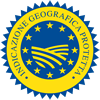Description
The Marrone di Castel del Rio PGI refers to the fresh fruit deriving from chestnut trees belonging to the species Castanea sativa Miller, deriving from the Marrone Domestico, Marrone Nostrano and Marrone di San Michele biotypes.
Production Area
The production area of Marrone di Castel del Rio PGI is within all or parts of the territory of the following municipalities: Castel del Rio, Fontanelice, Casal Fiumanese and Borgo Tassinaro, in the Province of Bologna, in the Emilia-Romagna region.
Production Method
The chestnut groves must be situated at an altitude of 200-800 metres above sea level. Newly planted chestnut trees should be exclusively of the Marrone Domestico biotype. The plantations, growing methods and pruning systems used must be those which are traditional of the area. During the productive stage, forced growing, the administration of synthetic fertilizers, and the use of pesticides are not permitted. The start of the harvest depends on the level of ripening, which varies based on the climatic conditions. After harvesting, the chestnuts are sorted, graded and immersed in cold and/or hot water (a practice known as “curatura”), in accordance with traditional local methods.
Appearance and Flavour
Marrone di Castel del Rio PGI is a medium-large size and has an easily detachable peel. It is reddish brown with well-defined darker streaks; the pulp is sweet and crunchy, and the outer surface doesn’t have any grooves.
History
Chestnut growing in the Bologna area boasts an ancient history and has always been an important business for the region. Around the middle of the 16th century, the Santerno Valley presented the Governor of Romagna with “twelve pairs of capons, one hundred libras (roughly 100 lbs) of Marzola cheese, one hundred rose apples, known as paradise apples, forty thrushes, two hares, and six baskets of chestnuts”. Not surprising seeing as it is one of the most prized fruit in this area, widely cultivated in the Apennine Mountains since the year 1000, when chestnut tree groves replaced oak woods and became a fundamental food and economic resource. Since then, production has been carefully regulated. In 1694, an edict states that “a large part of the income earned in the Castel del Rio area comes from chestnuts”, thereby encouraging the plantation of new trees for every one that was cut down. It was only during the 17th century that the areas of chestnut groves decreased, due to the wide spread diffusion of corn and potatoes. The construction of the Strada Montanara through the valley between 1829 and 1882, as well as the advent of the railway system, encouraged a larger diffusion of chestnuts across Italy and abroad.
Gastronomy
Marrone di Castel del Rio PGI should be kept in a cool, dry place. It can be eaten either fresh or processed. Its simplicity and versatility makes it an ideal main ingredient in numerous culinary dishes, such as pheasant, tagliolini pasta and omelettes, as well as castagnaccio (chestnut cake) and meringues. And, of course, the traditional roasted and boiled chestnuts, which are typically eaten with Muscat or raisin wine.
Marketing
The product is marketed as Marrone di Castel del Rio PGI and is available in two varieties: natural (fresh consumption) and as an ingredient in composite, elaborated or processed products. The product destined for fresh consumption must be packaged in containers made of food-grade materials, with a maximum weight of 10 kg, while there is no weight restrictions for the product destined to be an ingredient in composite, elaborated or processed products.
Distinctive Features
Marrone di Castel del Rio PGI can be distinguished from the common chestnut by its large size and in particular its smell, which is enhanced with cooking, as well as by being easy to peel.



















